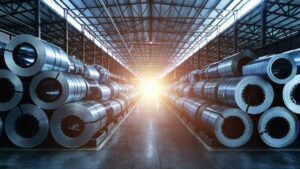Ground Breakers: BHP could shut nickel business as it sieves cash

Pic: DNY59/E+ via Getty Images
BHP (ASX:BHP) has responded to the downturn in the Western nickel market by smashing the value of its Nickel West business, cutting US$3.5 billion pre-tax and US$2.5b in post tax value in a massive impairment.
The business is now worth NEGATIVE US$300m including US$900m in closure and rehabilitation provisions and BHP has flagged it could place the entirety of its Nickel West business in care and maintenance.
They employ over 2500 people across WA at BHP’s Kwinana refinery, Kalgoorlie smelter, Kambalda concentrator and Mt Keith and Leinster mines.
Nickel West is also a major local supplier of sulphuric acid and processes third party material from other miners including IGO (ASX:IGO).
The division is expected to reveal a US$200m loss in next week’s half year financials.
It comes just weeks after crisis talks with the State and Federal Governments in response to a wave of mine closures and curtailments in WA, after a surge in supply from Chinese-backed Indonesian operators saw prices halve in the past 18 months.
BHP said the LME’s decision to begin accepting nickel of Indonesian origin as class 1 product had also hit benchmark prices,
An upgrade of the Kalgoorlie Nickel Smelter and the development of the $1.7b West Musgrave project, acquired in its $9.6b Oz Minerals deal along with the miner’s South Australian copper mines, now appear to be under threat.
The West Musgrave nickel and copper sulphide mine, a large but low grade development on WA’s border with SA in the remote Ngaanyatjarra Lands, is around 21% complete.
“This is an uncertain time for the Western Australia nickel industry and we are taking action to address the current market conditions. We are reducing operating costs at Western Australia Nickel and reviewing our capital plans for Nickel West and West Musgrave,” BHP CEO Mike Henry said.
BHP has already had to announce the closure of its milling circuit at the Kambalda Nickel Concentrator, after its main supplier Wyloo Metals announced it would suspend mining at its Cassini and Northern Kambalda operations from the end of May.
The world’s biggest miner will also increase its provision for the failure of the Samarco JV dam via an income statement charge of US$3.2b after a decision on moral damages for the disaster against Vale and BHP from Brazil’s Federal Court in the order of US$9.75b.
BHP and Vale have filed a clarification motion against what they say are ‘certain factual inaccuracies’ in the decision including how damages are calculated, with appeals expected to take between two and five years.
BHP’s provision for Samarco will increase to US$6.5b.
The mining giant’s first half results are due on February 20.
BHP (ASX:BHP) share price today
South32 to sink US$2bn on zinc
South32 (ASX:S32) suffered a massive 92% crunch in after tax profits in the first half of 2024, with lower commodity prices seeing it make just US$53m in the December half, down from US$685m a year earlier.
But that fact, which has seen a share buyback paused and dividend payments slashed 92% from 4.9c to just 0.4c a share, has done little to dull the miner’s plan to invest further.
Significantly, the BHP spinoff has ignored weak near term conditions for battery and base metals to take a major plunge into the zinc market, announcing a US$2.16 billion ($3.33b Aussie) investment to build the Taylor mine in Arizona.
It has already parted with US$366m for critical path infrastructure and pre-sink shaft activities since a PFS in January 2022. South32 spent US$1.3b buying TSX-listed owner Arizona Mining in 2018.
Part of the company’s Hermosa project, it will run for 28 years at an average EBITDA margin of around 50% but an internal rate of return of just 12%, lower than the 15% typically cited to back investments by majors.
Coming to market in the second half of 2027 and expected to hit nameplate output of 132,000tpa zinc, 163,000tpa lead and 8.5Mozpa silver by 2030, equivalent to 290,000tpa zinc a year.
On an average life of mine basis, production will come in at 114,000tpa zinc, 142,000tpa lead and 7.4Moz silver for 253,000t ZnEq.
The mine is expected to turn over US$400m in EBITDA annually at average all in sustaining costs of 16 US cents per pound of zinc, with commodity prices from FY31 expected to total US$3207/t Zn, US$2069/t lead and US$20.2/oz for silver.
Currently zinc is paying just US$2314.5/t on the LME, but South32 boss Graham Kerr is confident severe shortages are going to emerge in the coming years as its use in EVs, wind turbines and solar panels lifts.
“As one of the few shovel ready projects in the United States, and as industry-wide inflationary pressures begin to ease, we see potential opportunity to optimise the construction costs of Taylor,” Kerr said.
“Once in production, Taylor is expected to add an additional 8% to Group volumes relative to FY23 levels, increasing our supply of critical commodities and sustainably lifting margins due to its first quartile cost position.
“With global zinc demand growth expected to outpace production by ~3Mt to 2031, we expect higher incentive prices for zinc as Taylor ramps up to nameplate capacity.”
South32 (ASX:S32) share price today
On the nose
It comes despite concerns around other battery and base metals in the South32 portfolio.
Notably, its Cerro Matoso ferronickel project in Colombia, which only receives prices equivalent to around 70% of the already sapped LME benchmark, is under review after losing US$14m in the first half.
Nickel prices accounted for US$121m of the dive in first half underlying EBIT from US$922m to US$236m, with manganese and thermal coal price impacts coming in at US$102m and US$22m, on top of a US$136m hit on aluminium pricing and US$33m on alumina.
That was only partially ameliorated by higher copper and silver prices, which made a positive contribution of US$15m and US$8m.
Lower caustic soda and coke prices will bring costs down across S32’s operations, especially in its aluminium and alumina businesses.
But inflationary pressure, lower sales volumes and controllable costs saw an almost US$500m to earnings between them, with a notable US$267m hit coming from lower sales at the Illawarra met coal operations.
S32 expects production to improve in the second half, rising 7% on a copper equivalent basis.
Whitehaven sinks as acquisition and lower prices crimp dividend
Whitehaven Coal (ASX:WHC) saw its shares drop almost 5% on the open after revealing a big drop in underlying net profit after tax for the first half of FY24 from a record $1.8 billion last year to $372.3m.
It will see shareholders pocket 7c per share in fully franked dividends, down from 32c at the same time last year, when a generous buyback offer was also in play.
The status of Whitehaven’s returns to shareholders was a subject of controversy in the lead up to the deal to spend up to $6.4 billion on BHP’s Daunia and Blackwater met coal mines, with hedge fund Bell Rock Capital leading an unsuccessful attempt to intervene.
It was later revealed Bell Rock held an interest additional, undisclosed securities, which specifically benefitted from higher dividend payments. It later sold down its position.
WHC expects to payout 20-50% of NPAT from its thermal coal mines with earnings from its new met coal assets to initially pay off the finance it is raising to fund the deal, with the share buyback remaining on hold.
WHC produced more coal, with run of mine production from its NSW thermal coal mines up from 8.8Mt last year to 10.3Mt in the first six months of FY24.
But its statutory NPAT fell to $257.6m on costs related to the planned acquisition and a drop in revenue from $3.8b to $1.6b as average realised prices fell from giddy highs of $552/t in H1 FY23 to $220/t in the first half of this financial year.
“In the first half of FY24, high-CV thermal coal prices moderated but remained resilient, as energy security is a priority for power utilities globally. Whitehaven achieved a realised average price of A$220 per tonne in the half year,” Whitehaven CEO and MD Paul Flynn said.
“The open cut operations performed consistently well in the half year with good mining conditions and an easing of labour shortages. Our Narrabri underground mine experienced adverse geological conditions, which impacted productivity.”
WHC remains bullish on the long-term supply demand dynamics for high CV thermal coal, warning supply was not keeping pace with an average gCoal Newc index price of US$141/t coming in the first half despite weak seasonal demand.
But the premium low vol hard coking coal index remained in the order of US$298/t, boding well for its planned $6.4b purchase in April of two of BHP’s Queensland met coal mines.
Whitehaven Coal (ASX:WHC) share price today
UNLOCK INSIGHTS
Discover the untold stories of emerging ASX stocks.
Daily news and expert analysis, it's free to subscribe.
By proceeding, you confirm you understand that we handle personal information in accordance with our Privacy Policy.








